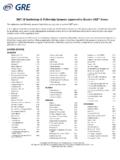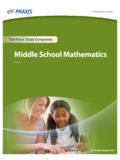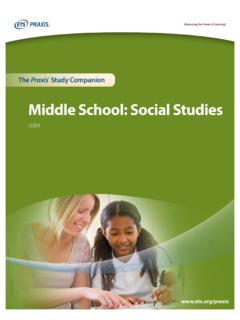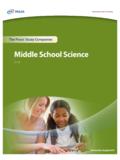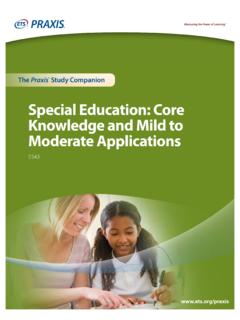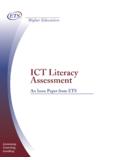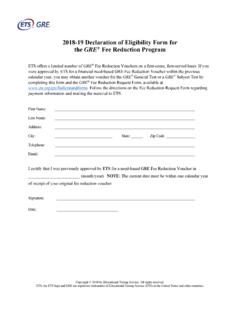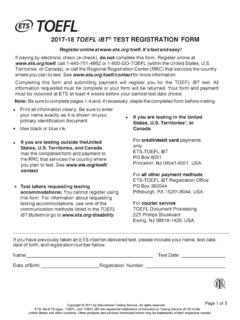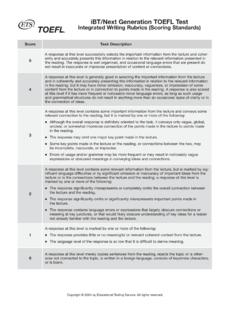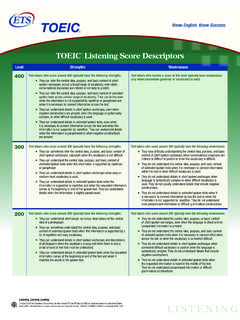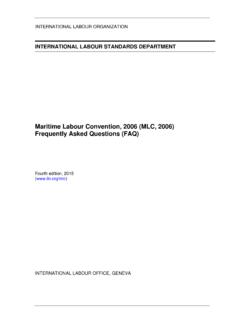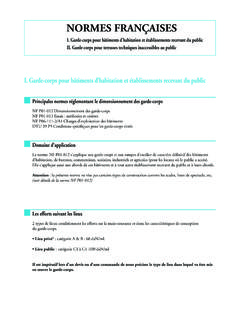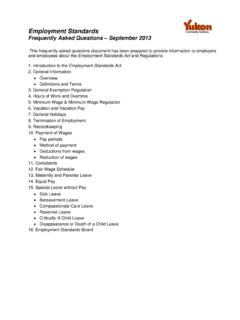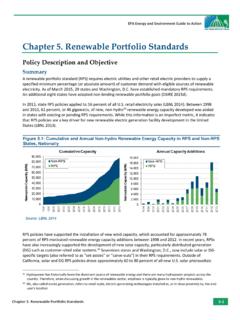Transcription of E. T. S. Standards for Quality and Fairness 2014
1 ETS Standards for Quality and Fairness2 014 ETS Standards for Quality and Fairness2 014 ETS StandardsiiCopyright 2015 by Educational Testing Service. All rights reserved. ETS, the ETS logo and LISTENING. LEARNING. LEADING. are registered trademarks of Educational Testing Service (ETS). Advanced Placement and SAT are registered trademarks of the College Board. All other trademarks are property of their respective owners. 29607 ETS StandardsiiiTable of ContentsPreface ..1 Introduction ..2 Purpose ..2 Relation to Previous ETS Standards and to the Standards for Educational and Psychological Testing.
2 2 Application of ETS Standards ..2 Audit Program ..3 Overview ..4 CHAPTER 1 Corporate Responsibilities ..5 Purpose ..5 Standards ..5 CHAPTER 2 Widely Applicable Standards ..9 Purpose ..9 Standards ..9 CHAPTER 3 Non-Test Products and Services ..11 Purpose ..11 Standards ..11 CHAPTER 4 Validity ..15 Purpose ..15 Standards ..15 CHAPTER 5 Fairness ..19 Purpose ..19 Standards ..19 CHAPTER 6 Reliability ..25 Purpose ..25 Standards ..25 CHAPTER 7 Test Design and Development ..29 Purpose ..29 Standards .
3 29 CHAPTER 8 Equating, Linking, Norming, and Cut Scores ..35 Purpose ..35 Standards ..35 ETS StandardsivCHAPTER 9 Test Administration ..39 Purpose ..39 Standards ..39 CHAPTER 10 Scoring ..43 Purpose ..43 Standards ..43 CHAPTER 11 Reporting Test Results ..45 Purpose ..45 Standards ..45 CHAPTER 12 Test Use ..49 Purpose ..49 Standards ..49 CHAPTER 13 Test Takers Rights and Responsibilities ..51 Purpose ..51 Standards ..51 Glossary ..54 ETS Standards1 PrefaceThe ETS Standards for Quality and Fairness are central to our mission to advance Quality and equity in education for learners worldwide.
4 The ETS Standards provide benchmarks of excellence and are used by ETS staff throughout the process of design, development, and delivery to provide technically fair, valid, and reliable tests, research, and related products and services. Program auditors use the ETS Standards in a thorough internal audit process to evaluate our products and services according to these established benchmarks. The ETS Board of Trustees oversees the results of the audit process to ensure successful implementation of the ETS ETS Standards were initially adopted as corporate policy by the ETS Board of Trustees in 1981.
5 They are periodically revised to ensure alignment with current measurement industry Standards as reflected by the Standards for Educational and Psychological Testing, published jointly by the American Educational Research Association, the American Psychological Association, and the National Council on Measure-ment in Education. This edition of the ETS Standards also reflects changes in educational technology, testing, and policy, including the emphasis on accountability, the use of computer-based measure-ment, and on testing as it relates to English-language learners and individuals with ETS Standards for Quality and Fairness and audit process help to ensure that we provide tests, products, and services that reflect the highest levels of Quality and integrity, and that we deliver tests and products that meet or exceed current measurement industry Standards .
6 They help us achieve the mission, and demonstrate our commitment to public accountability. The ETS Standards and audit process are a model for organizations throughout the world that seek to implement measurement Standards aligned with changes in technology and advances in measurement and MacDonald President and CEO Educational Testing ServiceETS Standards2 IntroductionPurpose The purposes of the ETS Standards for Quality and Fairness (henceforth the SQF) are to help Educational Testing Service design, develop, and deliver technically sound, fair, accessible, and useful products and services, and to help auditors evaluate those products and services.
7 Additionally, the SQF is a publicly available document to help current and prospective clients, test takers, policymakers, score users, collaborating organizations, and others understand the requirements for the Quality and Fairness of ETS products and SQF is designed to provide policy-level guidance to ETS staff. The individual Standards within the document are put into practice through the use of detailed guidelines, standard operating procedures, work rules, checklists, and so forth. Relation to Previous ETS Standards and to the Standards for Educational and Psychological TestingThis edition of the SQF owes much to earlier versions of the document as first adopted by the ETS Board of Trustees in 1981 and as updated in 1987, 2000, and 2002.
8 The earlier versions of the SQF and the accompanying audit process stand as tangible evidence of the long-standing willingness of ETS to be held accountable for the Quality and Fairness of its products and services. ETS strives to follow the relevant Standards in the 2014 Standards for Educational and Psychological Testing (also called the Joint Standards ) issued by the American Educational Research Association, the American Psychological Association, and the National Council on Measurement in Education. The SQF is intended to be consistent with the Joint Standards , but the contents have been tailored to the specific needs of ETS.
9 The Joint Standards is intentionally redundant, with the expectation that readers will focus only on certain chapters. The SQF is far less redundant, with the expectation that users will become familiar with all of the chapters relevant to their work. The SQF includes some material not included in the Joint Standards ( , non-test products and services), and excludes some material found in the Joint Standards that is not applicable to ETS products or services ( , clinical aspects of testing). Furthermore, the SQF is intended for use by ETS staff, and does not directly address others involved in testing such as designers of policy studies, program evaluators, and state and district testing directors, as does the Joint of ETS Standards The application of the ETS Standards in the SQF will depend on the judgments of ETS staff and external evaluators.
10 ETS intends the Standards to provide a context for professional judgment, NOT to replace that judgment. No compilation of Standards can foresee all possible circumstances and be universally applicable without interpretation. ETS does not intend the use of any of these Standards to stifle adap-tation to appropriate new environments, to slow the adoption of useful new technologies, or to inhibit improvement. If a consensus of sound professional judgments finds the literal application of a standard to be inappropriate in some particular circumstances, then the judgments should prevail.
